- 4 models of the latest VEGA 56 in Regard
- VEGA in Citylink is MUCH cheaper than everywhere else
- !!! GTX 1070 Gigabyte Stack 3x at an even MORE SUPER price
You can mark fragments of text that interest you,
which will be available via a unique link in address bar browser.
Choice optimal configuration for a gaming PC worth $400-500: March 2017
Phoenix 03/15/2017 00:00 Page: 1 of 4| | print version | | archive
- Page 1: Introduction, configuration, testing methodology
- Page 2: Test results in Battlefield 1, Quantum Break and Sid Meiers Civilization VI
- Page 3: Test results in StarCraft II: Legacy of the Void, The Elder Scrolls V: Skyrim Special Edition and Titanfall 2
- Page 4: Test results in Watch_Dogs 2, geometric average results of systems, conclusion
Introduction
IN this review Several configurations of gaming PCs will be tested, the cost of which falls within the price range from $400 to $500. The series of materials “Choosing the optimal configuration for a gaming PC” is purely advisory in nature and in no case is the ultimate truth.
The cost of components was formed by analyzing the prices of several large Moscow stores. Based on them, the arithmetic average price tag was calculated. Component manufacturers are listed for reference purposes only. Our readers are free to select specific configurations based on their preferences for a particular brand.
Let us remind you that you can familiarize yourself with the operation of test benches, the methodology and processing of testing results by clicking on this link.
Test configuration
Tests were carried out on the following stand:
- Motherboard #1: Gigabyte GA-Z170X-Gaming 3, LGA 1151;
- Motherboard #2: ASUS Maximus VII Hero, LGA 1150;
- Motherboard #3: Gigabyte GA-990FXA-UD5, AM3+;
- Motherboard #4: ASRock FM2A88X Extreme6+, FM2+;
- System CPU cooling: Corsair Hydro Series H105 (~1300 rpm);
- RAM #1: 2 x 4096 MB DDR4 Corsair Vengeance LPX CMK8GX4M1A2400C14 (Spec: 2400 MHz / 14-16-16-31-1t / 1.2 V), X.M.P. - off;
- RAM #2: 2 x 4096 MB DDR3 Geil Black Dragon GB38GB2133C10ADC (Spec: 2133 MHz / 10-11-11-30-1t / 1.5 V), X.M.P. - off;
- Disk subsystem No. 1: 64 GB, SSD ADATA SX900;
- Disk subsystem No. 2: 1 TB, HDD Western Digital Caviar Green (WD10EZRX);
- Power unit: Corsair HX850 850 Watt (standard fan: 140 mm inlet);
- Frame: open test stand;
- Monitor: 27" ASUS PB278Q BK (Wide LCD, 2560x1440 / 60 Hz).
Processors:
- Pentium G4520 - 3600 MHz;
- Pentium G4500 - 3500 MHz;
- Pentium G4400 - 3300 MHz;
- Pentium G3460 - 3500 MHz;
- FX-6300 BE - 3500 @ 4700 MHz;
- FX-4320 BE - 4000 @ 4700 MHz;
- FX-4300 BE - 3800 @ 4600 MHz;
- Athlon X4 880K - 4000 @ 4600 MHz;
- Athlon X4 870K - 3900 @ 4600 MHz;
- Athlon X4 860K - 3700 @ 4500 MHz.
Video cards:
- Radeon RX 460 2048 MB - 1206/7000 @ 1350/8000 MHz (PowerColor);
- Radeon R7 370 2048 MB - 975/5600 @ 1180/6800 MHz (PowerColor);
- Radeon R7 360 2048 MB - 1050/6500 @ 1200/6800 MHz (Gigabyte);
- GeForce GTX 1050 2048 MB - 1455/7012 @ 1770/8000 MHz (Palit);
- GeForce GTX 750 Ti 2048 MB - 1085/5400 @ 1220/6600 MHz (Gigabyte).
Software:
- Operating system: Windows 10 x64;
- Video card drivers: Nvidia GeForce 378.66 WHQL and AMD Radeon Software Crimson 17.2.1.
- Utilities: Fraps 3.5.9 Build 15586, AutoHotkey v1.0.48.05, MSI Afterburner 4.3.0.
System unit configurations
Option No. 1 (Pentium G4520 + GeForce GTX 750 Ti).
- Processor: Pentium G4520 - $100;
- Motherboard: Gigabyte GA-B150M-HD3 - $76;
- TOTAL: $498.
Option No. 2 (Pentium G4500 + Radeon RX 460).
- Processor: Pentium G4500 - $75;
- CPU cooling system: Cooler Master DP6-8E5SB-0L-GP - $6;
- RAM: 8 Gb DDR4 2133 MHz Kingston HyperX Fury - $71;
- Disk subsystem: 1 Tb SATA-III Western Digital Purple - $64;
- Case with power supply: InWin EC025 450W Black - $58;
- TOTAL: $470.
Option No. 3 (Pentium G4400 + GeForce GTX 750 Ti).
- Processor: Pentium G4400 - $62;
- Motherboard: Gigabyte GA-B150M-D3H - $78;
- CPU cooling system: Cooler Master DP6-8E5SB-0L-GP - $6;
- Video card: GeForce GTX 750 Ti 2048 MB - $123;
- RAM: 8 Gb DDR4 2133 MHz Kingston HyperX Fury - $71;
- Disk subsystem: 1 Tb SATA-III Western Digital Purple - $64;
- Case with power supply: InWin EC025 450W Black - $58;
- TOTAL: $460.
Option No. 4 (Pentium G3460 + GeForce GTX 1050).
- Processor: Pentium G3460 - $73;
- Motherboard: Gigabyte GA-H81-D3 - $65;
- CPU cooling system: Cooler Master DP6-8E5SB-0L-GP - $6;
- Video card: GeForce GTX 1050 2048 MB - $142;
- Disk subsystem: 1 Tb SATA-III Western Digital Purple - $64;
- Case with power supply: InWin EC025 450W Black - $58;
- TOTAL: $480.
Option No. 5 (FX-6300 BE + Radeon R7 360).
- Processor: FX-6300 BE - $87;
- Video card: Radeon R7 360 2048 MB - $108;
- RAM: 8 Gb DDR-III 1866 MHz Kingston HyperX Fury - $72;
- Disk subsystem: 1 Tb SATA-III Western Digital Purple - $64;
- Case with power supply: InWin EC025 450W Black - $58;
- TOTAL: $513.
Option No. 6 (FX-4320 BE + Radeon R7 370).
- Processor: FX-4320 BE - $68;
- Motherboard: Gigabyte GA-970A-UD3P - $81;
- CPU cooling system: Thermalright Macho 90 - $43;
- Video card: Radeon R7 370 2048 MB - $118;
- RAM: 8 Gb DDR-III 1866 MHz Kingston HyperX Fury - $72;
- Disk subsystem: 1 Tb SATA-III Western Digital Purple - $64;
- Case with power supply: InWin EC025 450W Black - $58;
- TOTAL: $504.
Option No. 7 (FX-4300 BE + Radeon RX 460).
- Processor: FX-4300 BE - $63;
- Motherboard: Gigabyte GA-970A-UD3P - $81;
- CPU cooling system: Thermalright Macho 90 - $43;
- Video card: Radeon RX 460 2048 MB - $120;
- RAM: 8 Gb DDR-III 1866 MHz Kingston HyperX Fury - $72;
- Disk subsystem: 1 Tb SATA-III Western Digital Purple - $64;
- Case with power supply: InWin EC025 450W Black - $58;
- TOTAL: $501.
Option No. 8 (Athlon X4 880K + Radeon R7 360).
- Processor: Athlon X4 880K - $88;
- Video card: Radeon R7 360 2048 MB - $104;
- RAM: 8 Gb DDR-III 1866 MHz Kingston HyperX Fury - $72;
- Disk subsystem: 1 Tb SATA-III Western Digital Purple - $64;
- Case with power supply: InWin EC025 450W Black - $58;
- TOTAL: $505.
Option No. 9 (Athlon X4 870K + Radeon R7 460).
- Processor: Athlon X4 870K - $80;
- Motherboard: ASRock FM2A88X Extreme4+ - $82;
- CPU cooling system: Thermalright True Spirit 90M Rev.A - $33;
- Video card: Radeon RX 460 2048 MB - $120;
- RAM: 8 Gb DDR-III 1866 MHz Kingston HyperX Fury - $72;
- Disk subsystem: 1 Tb SATA-III Western Digital Purple - $64;
- Case with power supply: InWin EC025 450W Black - $58;
- TOTAL: $509.
Option No. 10 (Athlon X4 860K + GeForce GTX 750 Ti).
- Processor: Athlon X4 860K - $70;
- Motherboard: ASRock FM2A88X Extreme4+ - $82;
- CPU cooling system: Thermalright True Spirit 90M Rev.A - $33;
- Video card: GeForce GTX 750 Ti 2048 MB - $123;
- RAM: 8 Gb DDR-III 1866 MHz Kingston HyperX Fury - $72;
- Disk subsystem: 1 Tb SATA-III Western Digital Purple - $64;
- Case with power supply: InWin EC025 450W Black - $58;
- TOTAL: $502.
Testing tools and methodology
For more visual comparison configurations, all games used as test applications were launched at a resolution of 1920 x 1080.
Built-in benchmarks, Fraps 3.5.9 Build 15586 and AutoHotkey v1.0.48.05 utilities were used as performance measurement tools. List of gaming applications:
- Battlefield 1 (Through Mud and Blood).
- Quantum Break (University Experiment).
- Sid Meiers Civilization VI (Turn 430).
- StarCraft II: Legacy of the Void (Premonition of Darkness).
- The Elder Scrolls V: Skyrim Special Edition (Riften Outskirts).
- Titanfall 2 (Operation Broadsword).
- Watch_Dogs 2 (Yacht Club).
Measured in all games minimum And average FPS values. In tests in which there was no possibility to measure minimum FPS, this value was measured by the FRAPS utility. VSync was disabled during testing.
50,000 rubles in 2017 is a decent amount to build a functional and reliable gaming computer. By carefully studying all the available components, you can understand that this amount is enough to assemble a functional model that will successfully run a variety of games and numerous modern programs.
CPU and cooler
First of all, you need to decide on a suitable processor. The best option is Intel, as they delight with performance, which compensates for the increased cost compared to AMD. Moreover, the current budget allows you to successfully overclock the assembly of a gaming computer.
At the same time, we can safely say that there is no need to chase numerous new products. Otherwise, you can spend about 50% of your budget on a Core i7 and be left with a weak video card that will not allow you to enjoy games.
The optimal processor option is i5 6600 and i5-6600K. The second option includes an unlocked multiplier, thanks to which you can successfully overclock the processor and guarantee maximum performance. If you understand the importance of other components, it is best to choose Intel Core i5-6400 Skylake, because it costs about 14,000 rubles and retains the ability to build a decent gaming computer. The rest of the money will primarily go towards the video card, but other components must also be functional.
Motherboard
Choosing the right motherboard is the second important task. It is advisable to focus on the processor.
A worthy option is the MSI H110M PRO-VD, since other models are overly expensive. MSI H110M PRO-VD Specifications:
- 4 connectors USB type 3.1;
- DDR4 DIMM 2133 MHz memory with two slots;
- 4 SATA connectors with a speed of 6 gigabytes per second;
- PCI-E x16 version 3.0.
Each of the above characteristics confirms that the motherboard turns out to be a real find, taking into account how powerful and advanced a computer should be.
Previously, you could afford to buy a motherboard with DDR3 support. However modern technologies limit opportunities, because the price of products has increased. In addition, DDR4 is offered at an affordable price.
RAM
Unfortunately, money runs out quickly, so it’s best to choose no more than 2,500 hryvnia rubles for RAM. In fact, this is enough for 8 gigabytes of memory with a frequency of 2133 MHz, making gaming activities possible.
Video card
Nvidia recently pleased its fans with the 10th series of video cards. You should definitely take advantage of this offer. A worthy choice would be the MSI GeForce GTX 1060 video card, which has the following parameters:
- frequency of the installed graphics processor – 1594 MHz;
- video memory volume – 6144 megabytes;
- video memory frequency – 8100 MHz;
- The video memory bus width is 192 bits.
This option should be used as quickly as possible. Otherwise, there is a risk of facing a rise in the price of components, the cost of which can increase to 30,000 rubles. A rise in price is most often caused by serious fluctuations in the exchange rate, which, unfortunately, are impossible to predict.
HDD

You can actually save money on this. For example, Western Digital WD10EZEX with a capacity of 1 TB costs about 4,000 rubles. If you wish, you can carefully study the Red and Black lines from WD, as they are also pleasing high level functionality.
If you wish, you can choose Toshiba or Seagate, because both brands offer worthy new products, but you need to understand that you still have to buy a power supply and a case.
Unfortunately, on SSD drive You won't be able to scrape together the money. If desired, you can later purchase an SSD and use it for installation operating system, programs. At this stage, you need to select a regular HDD.
power unit
The power supply must match the processor and card. The minimum power rating is 600 watts. A worthy option is the FSP Group ATX-600PNR 600W. If desired, you can choose Corsair, AeroCook Kcas 600W. It should be noted that Corsair offers branded parts, so FSP may not be to your liking.
Frame
Now there are no requirements. It all depends on your own choice. For example, you can choose a Midi-Tower without a power supply.
It is best to choose a high-quality steel case with a stylish design. The most important thing is the presence of fasteners, ports, compartments, on which functionality depends.
50,000 rubles should be spent wisely, despite the fact that this amount is enough for most purchases. The right approach to independently assemble a gaming computer allows you to enjoy decent options.
Video: build a gaming computer for 50,000 rubles 2017
The assembly will focus on you assembling everything yourself. You can see how to connect this or that part on YouTube. In fact, building a computer is not difficult. All prices shown are for January 2017.
1) Housing. Let's take B.U. the simplest, ATX format (mini ATX is not for everyone, I don’t like it, they are smaller). In Voronezh, components are sold through Avito and through the large Voronezh forum, where, by the way, you can sometimes find something even cheaper than on Avito. On Avito, normal cases cost 400-500 rubles, this will be enough. I don’t see the point in buying a new one for several thousand. Here in the picture below the case is sold for 400 rubles.
Then we move on to the components that will be installed directly into the case.
2) Power supply. I advise you to take a new one. I have FPS companies. I bought it in 2011 for about 1,500 rubles. Now you know what the prices are. There is DEXP DTS-500 for 1750 rubles. The warranty on the blocks is only 1 year. So, my FPS has been working for more than 5 years, I opened it several times and cleaned it from dust. In my opinion, it is better to take an expensive FPS, which has proven itself well, than DEXP and similar cheap power supplies. For example FSP PNR 500W costs 2850 rubles, there are a lot of positive reviews about it. A 500-watt power supply would be optimal in my opinion, because now new video card models are not particularly demanding on the power supply.
3) Motherboard. We take LGA775 for the socket, new ones are still on sale, but expensive - 3 thousand each. We are looking for used ones. on the same Avito or through friends. Why used? Because you will find a cheap, powerful processor for this socket. I will write more in detail below in the chapter about the processor.
We are not looking for just any kind, but for support Core processor 2 Quad. We look at the model name - supported processors. System bus 800 MHz - 1600 MHz. In a nutshell, the more powerful the tire, the more powerful processor supported. You can take it with a bus up to 1333 - the same will work.
It is advisable to buy a board so that 4 sticks of RAM are inserted, because... Large capacity DDR 2 may be difficult to find. I have 2 sticks of 2 GB and 2 of 1 GB, for a total of 6 GB.
ASUS P5Q SE/R is my board model. I bought it used. for 1 thousand rubles more than 5 years ago. The only negative is that it does not hold hibernation mode, it reboots instead. I heard that many people have this ASUS boards. You don’t have to look for such a board, there are many companies, search by parameters, when you buy you should be given a back plate, don’t buy without it, otherwise you won’t find it separately. You don’t need a driver disk or documentation, you’ll find it online, but if they give it to you, take it. Price 1000-1500 rubles, don't take more expensive ones.
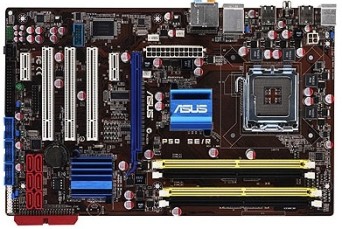
4) Processor. Do you really want gaming pc yuter, then take a 4-core one. The 2-core will be weak, even the latest Core 2 Duo models. I have Core 2 Quad Q6600, despite the fact that the processor of the year is 2007-2008 and one of the first 4-core ones, it still pulls at FULL HD to this day. GTA 5 at 35 fps, but my monitor is wider than FULL HD, I have 2560 by 1080 pixels, and FULL HD 1920 by 1080. I bought this processor for 1500 rubles boo. from one guy from the Voronezh forum. On Avito the price is about the same. The system bus of this processor is 1066 MHz (I wrote above in the board specifications).
If you take a more powerful processor, then take the Q9xxx series, that is, Q9300, Q9400, Q9450, Q9500, I won’t list all the models, because there are many of them, but one of the most powerful is Core 2 Quad Q9650. He demands system bus on the board at 1333 MHz. The processor is rare and can be bought for somewhere around 2,500 thousand rubles, or I think you can even get it for 3 thousand. There are also Q8400 and similar models, they are about the same as the Q6600, a little more powerful, the difference is small.
More Xeon processors(server) sell and offer a 775 socket with some kind of adapter. That is, they were originally designed for a different socket. I haven't tried installing these. In my opinion, if you take it, it’s better to use regular Quad than Xeon and worry about adapters.
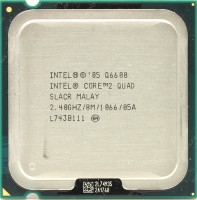
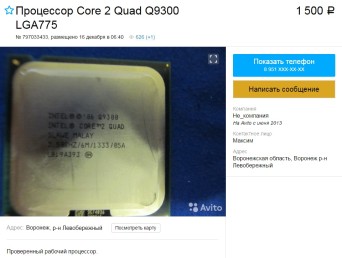
5) CPU cooler. For office tasks, watching movies and old toys, a boxed (standard) cooler is also suitable. But for serious games you need a serious cooler with at least several copper pipes for it. The cost is around 1000 rubles.

6) Random access memory (RAM). Boards for socket 775 usually support DDR2 memory. 6 GB will be enough for a gaming PC. You can put 8. Another option is to do it like I did: 2 2GB sticks and 2 1GB sticks. Or 4 sticks of 2 GB each. 2 strips should be identical. For example, you have 2 yellow and 2 black connectors. Insert identical strips into connectors of the same color. That is, put 2 x 2 GB in yellow, for example, and 2 x 1 GB in black or vice versa. Thus, you can install 2 from Samsung, for example, and 2 strips from another manufacturer, some hynix.
New on this moment 1 stick for 2 GB costs 1500 rubles. It is expensive. Boo. on Avito I now see advertisements for 750 rubles for 1 2GB stick, and the seller indicates that there are several of these. That is, you can find it. If you take 2 x 2 and 2 x 1 GB, it will come out to approximately 2200 rubles 6 GB. Take one frequency, I have PC 5300 667 Mhz - all 4 strips. If you take PC6400 800 Mhz, then take all 4 strips.

7) Hard drive. The last time I bought a Seagate Barracuda ST1000DM003, 64 MB cache memory. I have it now. It's been working fine for a year and a half. I got it for about 3800, but now I see it costs 3300 in one store. I took it to the CSN in Voronezh. It was a little more expensive in other stores. Prices can jump, so we count on the screw~ 3500 rubles. There is no point in taking 500 GB, because... it is several hundred rubles cheaper. Taking 2 TB will cost one and a half to two thousand more.
Boo. I don’t recommend taking it, I took it several times when finances were tight. I bought 500 GB for 1 thousand rubles. I couldn't even install Windows. We agreed with the man to pay for 3 days. I returned it to him the next day. It’s not clear why you should sell a dead piece of metal, especially if you own a flower shop and drive a cheap car. For a penny people will suffocate. I once took hundreds for four for 80 GB. The hard drive worked somehow, slowly, but something could be done, although the system slowed down quite a bit. There were also more or less normal ones hard disks, I remember I took it for 250 GB, CrystalDiskInfo showed good condition and the tin worked for a year and a half. But it's better to get a new one HDD, they are new and now they are not of particularly high quality, but at least there is no guarantee and if bad sectors then they must exchange. Previously, hard drives were of better quality. My previous WD blue 500 GB lasted 2 years and broke down quickly and unexpectedly, so I didn’t have time to download data from it. So it's lying around somewhere.
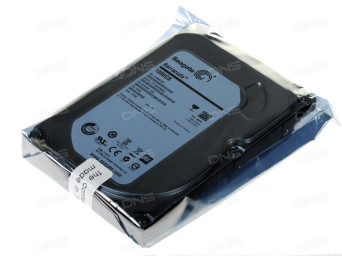
8) Video card. Attention, your video card must have a connector for your monitor. If you already have a monitor, then start from its connection connector. Old monitors have VGA connectors, newer ones have DVI connectors and the newest ones have HDMI connectors. I bought myself a video card and it has all 3 connectors. If the monitor is VGA and the video card has DVI connector, then this can be easily solved by installing a DVI-VGA adapter.
This article is about a gaming computer. Games are constantly being released, increasingly demanding on hardware. After the dollar rate soared, the Core i 3 processor became almost 3 times more expensive. Now it costs about 9 thousand rubles. We will have a processor for 1500-3000 rubles; i3 is dual-core with two threads each core, that is, the computer is defined as 4-core. Fast processor. But we will have a Quad, 4-core, albeit older, but not much inferior in performance, the difference there is extremely small, and the latest Quad models even outperform the i3 in some tasks, despite the fact that we take used ones. 3-6 times cheaper.
If you are planning to build a gaming computer to play GTA V, The Witcher 3 and similar demanding games, then you need to take a video card with 2 GB of memory, memory type ddr5/gddr5 and a 128-bit bus. Under no circumstances should you buy ddr3/gddr3 video cards, much less ddr2/gddr2. There are video cards, maybe with 4GB of memory, but ddr2, your old games won’t even run at maximum speed.
My first gaming GeForce video card The GTX 460 GDDR5 768 mb with a 192-bit bus from Palit was pretty good. GTA 5 ran at low resolution, but it was only 768 MB. It served for exactly 3 years, despite the fact that I bought it used. in store with a two-week guarantee. I fried her with an iron a couple of times before her death, but that’s not about that now.
The video card should be taken based on the processor power. Gamers call this “unleash your potential.” When playing GTA V at a resolution slightly higher than FULL HD (2560 by 1080), I found that the CPU was running at almost 99% with my new graphics card. By the way, it is called from MSI 2 GB GDDR5 with a 128-bit bus. Despite the reduced number of bits in the bus, it is on par with analogues from Radeon, which have a 256-bit bus, for example R7 370. Later a video card came out from Radeon RX 460, also 2 GB, the bus is no longer like the R7 370 256 bits, but 128 bits. At the same time, the power is the same, but it is less demanding on the power supply. As for playing GTA V, my processor is almost completely loaded, and the video card can be loaded even more, that is, the weak point in my system is the processor. If you take a weaker video card, the ratio of processor power to video card will be approximately equal. Or take a more powerful processor, but this is not necessary, for example, I am happy with everything as it is and it is not so important that the processor does not reveal the full potential of the video card. I have most modern games running, although I don’t play them much, I like Gothic 3, you know how beautiful it is, no perfect game, there are some things I don’t like, but overall everything is very good. On YouTube you can watch tests of certain games with different hardware characteristics, you need to write the name of the video card, processor and game in the search bar, you can also add the phrase “test fps” (frames per second).
GeForce GTX 750 ti - I bought a new one in the spring of 2016 for 9200 rubles in Yulmart from MSI. I liked MSI because it has Twin Frozr IV Advanced cooling. Two cooling coolers and I read a lot of positive reviews about it, plus watched quite a few videos before buying. Now I haven’t found such a model in Yulmart, there are other companies. From gigabyte also with 2 coolers it costs 8130 rubles. And I found one in the Voronezh CSN for 8,700 rubles. When I bought it, it was more expensive at CSN than at Yulmart. I liked the video card, sometimes once a month the screen goes blank for a couple of seconds and a message appears at the bottom saying that the video driver has stopped responding, probably the problem is in the driver, which I’m too lazy to reinstall, but I’ll tell you that’s nonsense. I checked the temperature, it is not high, even under load.
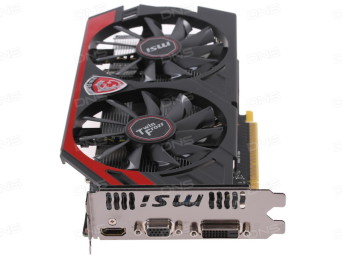
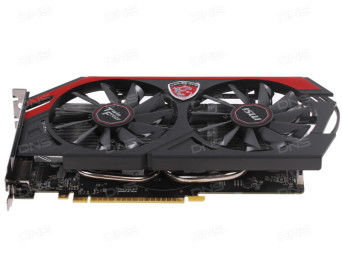
By the way, I was thinking about buying a used one. I think the model was called R 290 video card, but I couldn’t find it. But that new model was no longer sold. About used I didn’t even think about 750 ti, because... model new and used It was almost impossible to find one like that back then, and on Avito video cards in Voronezh sold practically nothing but slag, or very expensive ones. For example, the GTX 560 ti is not a bad video card; it certainly won’t work for the GTX V, because... It's 1 GB, but you can play many other games comfortably with it, it's more powerful than my old GTX 460 and has a little more memory. But do you know how much they sell it for? 5 thousand rubles each. This is funny. Well, it's not worth that much money. 3000 rubles is the maximum I would offer for it. This is right here with the box, documents and receipt if.
I don’t recommend taking a cheaper video card, but for 2 GB, 740 model, it’s better to save up for 750. Here’s the Radeon RX 460, one model I now see for 7600 rubles from Asus. I don’t know whether it’s good or bad, maybe it’s not bad, read reviews, watch video tests. 1 GB video cards (with a bus of 128 and GDDR5 memory) cost from 5 thousand rubles. Save up to ~8500 and buy a good video card, it will serve you for many years and you will not be disappointed in the graphics.
If games like GTA 5, The Witcher 3 and other heavy games are not so important to you, then look for a 1GB used video card. but a really working one, preferably from some friend or person with a good reputation (like we have on the Voronezh forum), GTX 460, 550 are good video cards, a 500-watt unit will be enough. Such a video card will cost you 2000-2500 rubles. Run games on high settings, load the video card properly, see if the computer turns off after a while, maybe the thermal paste has dried out, then replace it, I apply cheap KPT-8 and it’s fine. I remember from the gtx 460 the computer turned off, the video card overheated, when playing games at FULL HD resolution the temperature seemed to be above 90 degrees of the video card and the computer turned off. Then I found out that there was a protective piece of hardware installed on the chip, I disassembled the video card, removed this thing from the chip and put it back together. The chip began to cool better and there was no more overheating. But as I understand, this protective contraption is not available on all models, and may even be installed on a very small number of video cards.
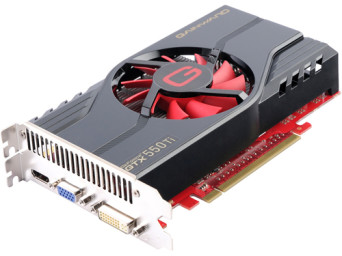
9) Monitor. If you don’t have it, then take FULL HD at 21.5 inches, I had one, best option price quality. I don’t recommend the dubious company DEXP for 5 thousand, pay an extra 1 thousand and take it for 6 thousand LG or Philips. I have 2 Philips monitors, one Samsung and the last one I bought was LG 29 inch. Before this I used a Philips 21.5 inch. I took the last one for 15.5 thousand rubles, supposedly at a discount, so it cost about 19, widescreen, many films run full screen, although videos on YouTube are now, on the contrary, not full screen, because... there is a FULL HD format, but it's not scary. My latest monitor certainly isn't a budget option, so I won’t write about it.

I am not adding the drive to this list, because... Rarely does anyone use it; if you decide to take it, add a little more than a thousand rubles. Take it to write CDs and DVDs.
I also don’t add computer speakers to the list; if you don’t have them, look at your budget. My first speakers were for 150 rubles, which were bought back in 2005. Now I have a Defender Mercury 55 MKII 60 W, I bought it in 2011 for about 3,300 rubles. In 2016 I took it in for repairs, they fixed it for 1,500 rubles, they already cost around 7,000 rubles. And they fixed it by replacing some kind of diode that cost 50 rubles, who knows what. (There was a strong hum in the speakers).
You will also need a screwdriver and bolts to assemble the computer. The bolts for attaching the power supply seem to be included in the kit. But you’ll have to look somewhere to screw in the motherboard and hard drive. I bought some spare parts at a small computer store and asked them about bolts. A kind sales assistant put a small box of bolts on the table and offered to take as many as needed. Well, I took about 5 pieces (I didn’t take many, I’m a cultured person, not a redneck), then I found it somewhere else, I don’t remember. Now I myself have such a box with different bolts.
Sata cable for connection hard drive to the board, I don’t remember if it comes with hard drive, check with the seller. Not expensive, around 100 rubles.
Keyboard, mouse - your choice. I recommend a keyboard with low keys, it’s so comfortable and easy to press, I have the cheapest one with low keys dns, I bought it about 4 years ago for 350 rubles. I always take a regular cheap mouse like A4tech.
If the video card with additional food it will be, see if there is such a cord (Molex) on the power supply, if not, buy an adapter, it also costs around 100 rubles. On the GTX 460 I needed 2 6 pin power plugs. One was on the power supply, the second one was purchased with an adapter. On latest video card The GTX 750 does not require additional power at all (I was surprised, the video card is much more powerful, but without additional power it gives out).
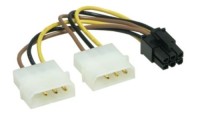
It may be difficult for a beginner to connect the wires from the case (power button, reset button, front usb). On the wiring there should be the inscriptions power sw, reset sw, these are the most mandatory ones; there may be no inscriptions on the motherboard. Search online for documentation for your motherboard, or try it yourself using guesswork and random guessing. I figured it out myself, it’s not difficult in principle. I don’t connect any wiring to the HDD and LED indicators. There's no need for the peephole to blink when the hard drive is working and so on. How to connect the front USB - look at Google images, I can’t tell you from memory.
Let's summarize how much money has accumulated.
Used housing 500r, new power supply 2850r, used motherboard. 1500r, used processor 1500 RUR, new cooler 1000 RUR, used RAM. 2200 RUR, new hard drive 3500 RUR, used video card. gtx 550ti 1gb 2500r. It turns out 15550 rubles 21550 rubles 22550 rubles. This takes into account the fact that you have good hardware and the video card can be replaced in the future with a more powerful one, without having to change or add anything.
Now let's replace the used one. 1GB video card to a new 2GB video card.
Used housing 500r, new power supply 2850r, used motherboard. 1500r, used processor 1500 RUR, new cooler 1000 RUR, used RAM. 2200 RUR, new hard drive 3500 RUR, used video card. gtx 750ti 1gb 8700r. It turns out 21750 rubles- one system specialist. If with a monitor, then add 6000r, it will work out 27750 rubles. Let's add a cheap keyboard, mouse and speakers - 1000 rubles. Will come out 28750 rubles.
I decided to compare what the savings would be if I took everything new, added the items to the cart in the DNS and looked.
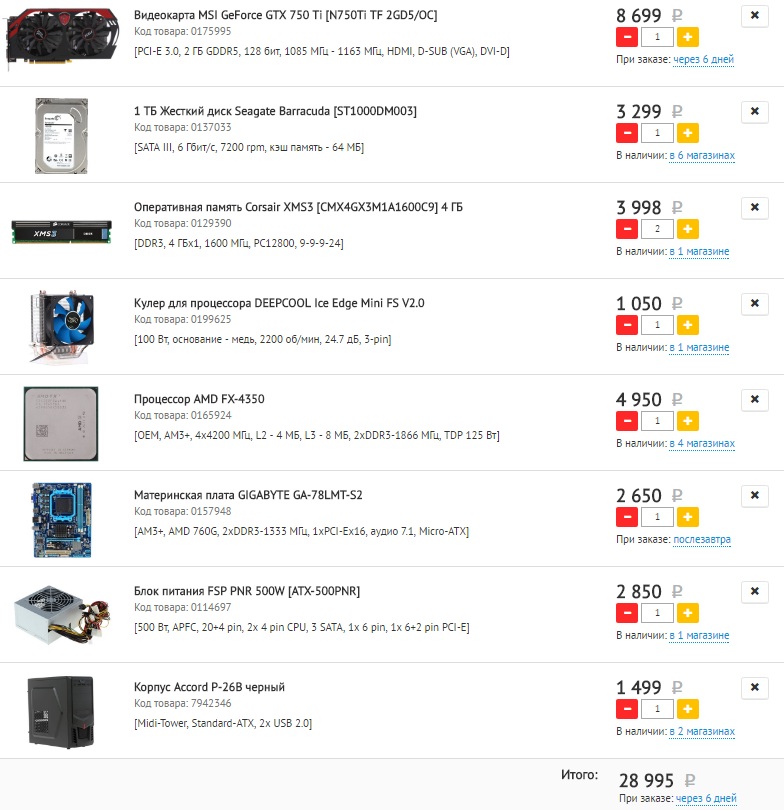
There was 2 GB more RAM than in my builds. Savings amounted to 7245 rubles. I chose the motherboard that quite a few people bought, judging by the reviews, one of the cheapest. I chose an AMD 4-core processor for the above motherboard. The power is about the same as the Coree i3, like the Core 2 Quad in my build, the difference is small. If you assemble a system for an Intel processor, it will cost 5 thousand more, in which case the savings with my assembly would be already 12245 rubles.
In a store-bought assembly, the memory is DDR3 versus DDR2 from my assembly, the hard drive will operate at the speed of the SATA3 interface versus SATA2 from my assembly, but this is basically nonsense, I’ll tell you, the difference is extremely small. Think for yourself, decide for yourself, assemble a system unit with a used processor. for a couple of thousand, either with a new one from AMD or with a new one, but i3 from Intel. Assembly for AMD will certainly be cheaper, think about it, it’s better, of course, to take everything at once and new, if finances allow. If you decide, then think about replacing the FX 4-core processor with an FX 6-core processor, the difference is only 1 thousand rubles. Well, I basically described everything to you. Maybe you’ll go your own way and take something used, maybe you’ll find cheap DDR3 memory for store-bought assembly of everything else, or something else. After purchasing/assembling a computer, if you don’t know how to install Windows and set everything up, ask a computer geek friend, ask your friends. In the store, they can assemble everything for you for an additional fee (provided that you buy the components from them), all you have to do is install the system and use the computer. For hospitals, I recommend Windows 7 64 bit without any bells and whistles and additional system decorations. And if you want to make the most of your hardware, that is, use Direct X12, then install Windows 10. Don’t forget to turn off tracking later, although I don’t think it will turn off 100%. I wish you to collect a good budget gaming computer in 2017
Valve's most popular gaming platform, Steam, regularly invites users to participate in an anonymous, automated survey that collects basic information about their computer's configuration. Based on the data received, Steam publishes statistics, which you can view.
Let's see how the preferences of Steam users in choosing certain components and systems have changed recently.
CPU
Over the past year and a half, the share of Intel processors has increased from 76.4 to 79.7%.
Notice how Intel's slow but steady share growth stalled earlier this year at 79.7%. The reason for this was the long-awaited release of a new generation of processors from AMD called Ryzen.
Ryzen turned out to be really successful and can be called worthy competitors Core i5 and i7, which have long held a monopoly on the gaming processor market.
Understand model range Ryzen is very simple because the digital markings of the new processors from AMD are the same as Intel products. Simply put, Ryzen 5 is a conditional analogue of Core i5, and Ryzen 7 is a conditional analogue of Core i7.
The growth of Intel's share stopped due to the fact that Steam users planning an upgrade were waiting for the results of real Ryzen tests and, judging by the dynamics, many of them preferred more affordable solutions from AMD.
Thus, for the first time in several years, AMD was able to release truly competitive processors, and this is always very good for the end consumer.
Video card
Over the past year and a half, the share of Nvidia video cards has increased from 54.5 to 61.5%, while AMD's share has decreased from 26.3 to 21.9%.
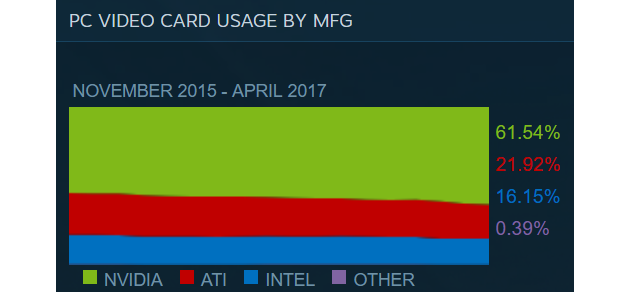
The situation is quite expected, since, unlike the processor battlefield, where AMD was still able to field worthy rivals, the video card segment is completely in the hands of Nvidia.
The tenth GeForce GTX series presented by Nvidia was a truly new step for the industry, offering users a new level of performance and energy efficiency at quite affordable prices.
AMD currently doesn't have anything that can compete with Nvidia beyond the entry-level (Radeon RX 470 4GB and Radeon RX 570 4GB vs. GeForce GTX 1060 3GB) and mid-range (Radeon RX 480 8GB and Radeon RX 580 8GB vs. GeForce GTX 1060 6 GB) price segments. That should change with the release of the Radeon RX Vega in the second half of the year.
Meanwhile, specialized technical sites are releasing more and more new recommendations, in which video cards from AMD are found only in budget configurations “up to 60 thousand rubles”, and the entire price range of high-performance assemblies “from 60 thousand and above” is completely occupied by Nvidia products (GeForce GTX 1070 , GeForce GTX 1080 and GeForce GTX 1080 Ti).
VR
The situation with VR has remained virtually unchanged over the past year.

The more technologically advanced HTC Vive is twice as popular as the Oculus Rift and is not going to give up any significant market share to its competitor.
System
The situation with Windows remains persistently unstable.

The wave-like graph shows how users upgrade to “ten” and, seeing a very unusual system compared to the previous one, roll back to “seven”.

On average, the share of Windows 10 among Steam users is about 53%, and Windows 7 can boast a share of 37%, having won a whole percentage from the “ten” and other versions over the past month.
What to build a gaming computer from
Obviously, the main guideline for most people who want to buy a gaming computer is budget. Unfortunately, after 2014 buy normal a new gaming machine for 20–25 thousand is impossible. And speech in in this case It’s not even about the entire computer (with monitor, etc.), but only about the system unit.
Sure, you can get a cheap computer that can barely run some games at medium-high settings now, but that's not the wisest decision.
In fact, you are spending a lot of money on an already outdated machine with limited upgrade options (new products for old sockets are not and will not be released).
Current sockets and standards (LGA1151 for Intel or AM4 for AMD, DDR4 support, and so on) provide much greater freedom for further upgrades.
It makes more sense to pay extra now, but at the same time buy a computer that will delight you with high or maximum graphics in all new games for another 2-4 years.
For each assembly, only the main components are listed, forming the lion's share of the final cost, without taking into account Windows licenses. Aftermarket parts such as the case, power supply, and cooling are included in the budget but not separately listed. You can easily select them yourself: using specialized sites or by consulting a familiar technician.
Budget 60,000 rubles
For playing at high / maximum settings graphics in Full HD.
- Processor and motherboard: Ryzen 5 1600 + B350 or Core i5 7500 + H110 Express.
- Video card: GeForce GTX 1060 6 GB, or Radeon RX 480, or Radeon RX 580.
- SSD: 120 GB or more.
Budget 80,000 rubles
For playing at maximum graphics settings in Full HD and high/maximum graphics settings in QHD.
- Processor and motherboard: Ryzen 7 1700 + B350 or Core i7 7700 + B250 Express.
- Video card: GeForce GTX 1070.
- RAM: 2 × 8 GB DDR4.
- SSD: 240 GB or more.
Budget 100,000 rubles
For playing at maximum graphics settings in Full HD and QHD.
- Processor and motherboard: Ryzen 7 1700X + B350 or Core i7 7700K + Z270 Express.
- Video card: GeForce GTX 1080.
- RAM: 2 × 8 GB DDR4.
- SSD: 240 GB or more.
Budget more than 100,000 rubles
For playing at maximum graphics settings in QHD and high/maximum graphics settings in Ultra HD.
- Processor and motherboard: Ryzen 7 1700X + X370 or Core i7 7700K + Z270 Express.
- Video card: GTX 1080 Ti.
- RAM: 2 × 16 GB DDR4.
- SSD: 500 GB or more.
When modifying any of the proposed configurations, it is important to remember the need to maintain a balance between processor and video card performance. Otherwise, one of the components will become a bottleneck, and the potential of a more powerful “partner” will remain unrevealed.
The recently true belief that 8 GB of RAM is enough for games is becoming a thing of the past. Nowadays, when buying a new computer, it is better to immediately install 16 GB of RAM so that there is a reserve.
If you have “extra” money and, accordingly, the opportunity to invest a slightly larger amount in an upgrade, look towards increasing the capacity of the solid-state drive. Modern games take up a lot of disk space, and with a 120–128 GB SSD capacity, you can install a maximum of two, and often just one, heavy game on it.
What to build a gaming computer in 2017 from? The best components for your PC
Do you want to know how to build a gaming computer for yourself in 2017 and what components are best suited for this? Still wondering how much to invest in a new PC? Can't decide which hardware manufacturer to choose? Then let's look at several options and find out what a home-built gaming PC could be like in 2017! But before we move on to comparing the possible “filling” for system unit, you need to decide on the budget for the upcoming purchase.
How much does it cost to build a gaming computer in 2017?
First, you need to calculate the amount that the user is willing to spend on such a significant purchase for him. And starting from the budget, you can safely move on to the selection of components. Why is this being done? Everything is very simple. If we are assembling an inexpensive gaming computer in 2016 for thirty thousand rubles, it makes no sense to look closely at top-end processors, motherboards and video cards. If we are talking about assembling the best gaming PC, the user should be ready to pay one hundred and fifty, and perhaps even two hundred thousand rubles for it.
The thing is that the flagship components that the manufacturer has just introduced to the market have (very often not entirely justifiably) a price tag that is too high. And the cost of hardware, which is quite a bit inferior to the top models in performance, but which went on sale more than six months ago, is gradually falling.
That is, assemblies of gaming computers in 2017 may differ significantly in budget depending on the chosen “filling” of the system unit and the date of appearance of accessories on store shelves. Take this fact into account and take a closer look at the price range that suits you best.
Step 1: select the processor and motherboard
The chip and the motherboard with the corresponding socket are the main components of any PC. Performance and power largely depend on them. In addition, the remaining components are much easier to replace in case of an upgrade. So it’s better to immediately spend money on good processor and the fee for it, and save on something else. For example, RAM or hard drive.
If you decide to build a gaming computer in 2017 without limiting yourself in anything, then it makes sense to forget about AMD and pay attention to Intel Core i7-6700K processors and Intel Z170 Express motherboards. Or even go for 6-core, 12-thread Core i7-5820K/6800K chips and X99 Express motherboards. But there won’t be much difference between them even in the most demanding games. But the cost of the second option is noticeably more expensive - at least five to ten thousand rubles.
In the case of a budget limited to sixty thousand, it is better to opt for a 4-core Intel Core i5-6400 and motherboard Intel B150 Express. And as an alternative to them, you can consider a kit from AMD, for example, the 8-core FX-8320 and the AMD 970 motherboard.
If you need a very inexpensive gaming computer costing no more than thirty-five thousand rubles, then it is best to choose one of the following options:
Processor FX-8320E and socket 970 from AMD;
- Intel processor Core i3 (at least 6100) and H110 Express motherboard from Intel.
Keep in mind that most experienced users prefer Intel products for a number of reasons (high reliability, low processor temperatures even at peak loads, etc.). Although some gamers prefer AMD chips due to their low cost and good overclocking potential.
Step 2: what about the video card?
A good graphics chip is the key to high-quality image display in games, even at maximum settings. That is why gamers extremely rarely save on video cards, the cost of which is sometimes almost half the price of the system unit.
For office PC or " workhorse“In many cases, the built-in graphics subsystem is sufficient. Gamers need a separate video card with good cooling, capable of working at peak loads for a long time and not overheating. Based on the cost of the graphics chip, it is best to choose one of the following models:
NVIDIA GeForce The GTX 1080 is a flagship card that will be enough for comfortable gaming even in Ultra HD. If you are not bothered by its cost and still want to significantly increase performance, then you can run two of these cards in SLI mode;
- NVIDIA GeForce GTX 1070 – a high-quality and powerful graphics chip, which is one and a half times cheaper than the model described above;
- Radeon RX 480 or GeForce GTX 1060 – if you want to build an inexpensive gaming computer in 2016, then buying one of these video cards (their cost ranges around twenty thousand rubles) will be the best solution.
Step 3: RAM and storage
If you need a powerful gaming PC in 2017 that can quickly process large amounts of data, then get ready to purchase at least eight gigabytes of RAM. Depending on the motherboard, this can be either DDR3 or DDR4.
But for the fastest reading and writing of data you will have to fork out for solid state drive(SSD). If desired, it can be used in conjunction with a more affordable hard drive. In this case, the SSD will be needed to install the system and your favorite games, and the HDD will be used to store movies, photos, music and other data.
Step 4: Important Details
Once you decide on the platform and the main components, there are only a few important details left. If we are assembling a top-level gaming PC, it must have the appropriate:
Backlight or transparent walls made of fiberglass, but also full compliance with the motherboard of all kinds of connectors;
- cooling. How more powerful computer and the more intensively it is used, the faster the hardware inside the system unit heats up. Low-cost builds most often use air cooling, which includes several coolers. The most expensive PCs usually come with more efficient liquid cooling systems;
- power unit. Its power should be enough for normal operation all components. It’s even better to purchase a high-quality power supply from a well-known manufacturer with a small, at least 50 W, reserve.
Now you know what to build a 2017 gaming computer from. And, based on your budget, you can easily purchase the best components for your future PC.
